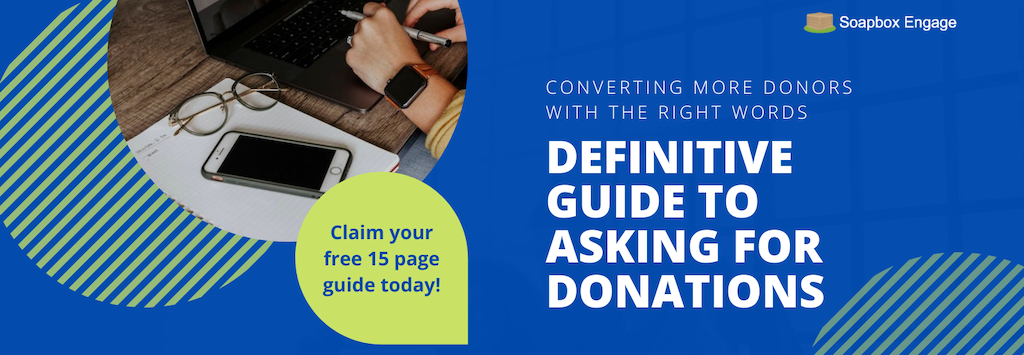
Do you work for an organization that seeks to enact real, measurable change around a specific cause, policy, or position? A significant part of the work of many nonprofits includes advocacy. You're probably very invested in raising awareness, lobbying, and using other methods to change (or create) laws, influence people’s opinions, and bring about social change.
Whether your organization is directly or indirectly involved in advocacy, advocacy campaigns help nonprofits raise awareness about their mission and mobilize supporters to take action. Advocacy also helps organizations raise money!
Every advocacy campaign is different, with a wide range of goals, causes, advocates, and other variables. With the right preparation, you’ll be able to run a powerful, effective advocacy campaign. We put together a basic strategic plan to help you get started on your early advocacy campaign planning.
What is an Advocacy Campaign?
Advocacy campaigns are as diverse as the types of organizations that put them on! That’s part of their beauty. You can use these campaigns in conjunction with everything from fundraising and marketing to lobbying, outreach, and community service. No matter what they look like, advocacy campaigns enable organizations to raise awareness and mobilize their supporters.
What’s the difference between advocacy and lobbying?
Nonprofit advocacy is usually a slow, long-term effort. It often focuses on educating people and promoting specific services more than trying to enact political or legislative change.
Nonprofit lobbying, on the other hand, supports or opposes legislation, candidates, officials, or other legal and political matters. Nonprofit lobbying usually involves staff and volunteers working to influence lawmakers or laws on behalf of the organization. Lobbying typically happens before a vote.
Many nonprofits use lobbying to educate their supporters and donors about pieces of legislation that, in their opinion, benefit or harm the organization’s mission or its audience.
There is a fine line between advocacy and lobbying that can be difficult to navigate. Too much lobbying can lead to a nonprofit losing their tax-exempt status. By law, 501(c)(3) organizations cannot participate in political campaigning or similar activities. The exception is that public charities are allowed to participate in lobbying efforts to impact legislation (however, there are financial restrictions and regulations).
Types of Advocacy
There are three main categories of advocacy campaigns used by nonprofits.
Peer Advocacy: Peer Advocacy is when individuals advocate for someone else, usually in a one-on-one context. One of the most common types of peer advocacy is when the advocates have shared experiences with the people for whom they are advocating, making it easier for them to communicate on behalf of the community.
For example, teachers who work in underfunded school systems can advocate for their students’ needs because they work closely with those students and understand the unique challenges in the specific learning environment. These teachers know what resources the schools need and can ask city and state officials to provide them.
Cause Advocacy: Cause advocacy campaigns champion a specific cause or issue that an organization (and its supporters) are passionate about. This type of advocacy campaign might be spearheaded by a nonprofit, a group of people, or even individuals who are committed to raising awareness and finding a solution.
One example of cause advocacy comes from rural Buckingham County in Virginia. The Friends of Buckingham County organization organized an advocacy campaign to protest the Atlantic Coast Pipeline going through their community. The organization connected with other communities and sought to shed light on how the proposed pipeline project would negatively impact their community.
Systems Advocacy: Systems advocacy is a type of cause advocacy on a much larger scale. A systems advocacy campaign has a goal of effecting change within a social, economic, or political system. This type of advocacy campaign can include everything from lobbying and fundraising to awareness campaigns and efforts to educate the broader population.
An example of an organization dedicated to systems advocacy is the International Justice Mission. Their goal is to end all forms of modern-day slavery around the world, not just one case at a time, but by creating and changing laws (among other things).
4 Easy Steps To Plan a Successful Advocacy Campaign
Organizations are really only limited by their resources and their imagination to come up with ways to broadcast their cause and rally support. Still, there are some practical steps you should take to ensure your campaign is successful.
1) Set a specific goal
What exactly do you want to accomplish with your advocacy campaign? The more specific you can be, the better! Your particular campaign might be part of a broader movement for change, but every advocacy campaign needs a specific, measurable goal that people can understand and rally behind.
Make sure your goals are SMART: Specific, Measurable, Achievable, Relevant, and Time-bound.This will help you write goals that have a specific outcome in mind that people will understand. Well-written goals help mobilize people to take action! SMART goals are critical for advocacy campaigns in which you are trying to mobilize regular people, not advocacy professionals, to take action.
Specific goals keep people focused on the task. It’s also easier to be encouraged and stay engaged when you can measure progress.
2) Clarify your message
Now that you have a SMART goal, you can write a clear, compelling message that unifies your supporters and attracts people to your advocacy campaign. People need rallying cries that are motivating and easy to remember.
Your organization might be involved in a variety of issues and causes, but each advocacy campaign should have a specific, clear message.
Imagine if several hundred supporters showed up to a rally about providing school lunches for at-risk youth, and there was confusion about what county, school district, or state you were advocating for. What a mess!
3) Create a timeline for your campaign
You don’t need to map out every detail in advance, but your advocacy campaign needs a timeline that outlines your end goal and the major events, challenges, and opportunities along the way that you will need to either capitalize on or overcome.
Start with specific deadlines, decision dates, or other time-specific events, then add other key events and "benchmark dates." As you continue to fill out the timeline, this will guide your decisions about what tactics and strategies will be most helpful.
You might not know what you will need to communicate with your network of supporters yet, but you’ll probably want to share critical information along the way. Add a general timeline of communication with your supporters. You can adjust as you go, but having a schedule helps ensure it gets done on time and helps your campaign.
If you don’t already have a CRM system or online directory to gather and organize contact information, now is the time to get one! Advocacy campaigns are an excellent way to connect with more people who are passionate about your mission! You’ll want to stay in touch with them long after your campaign is over.
4) Get organized and mobilize
Now that you have a goal and a message, it’s time to organize and mobilize your supporters. This will probably require some customized online resources.
If one of your goals is to raise money, you should create a custom donation page for your advocacy campaign. If your campaign involves collecting signatures or mobilizing people to contact specific people about an issue, then you’ll need to create a way to gather that information in one spot or have an online petition. Online forms and customizable petitions are beneficial for almost every advocacy campaign.
Many organizations find it helpful to create common platforms for people to share their stories. Some organizations create Facebook groups or custom pages on their website for people to share their personal stories. Other organizations use hashtags and different creative strategies.
The ALS Association’s #IceBucketChallenge advocacy campaign went viral. People tagged their ice bucket challenge videos with the hashtag, and individuals suffering from ALS shared their stories. It raised awareness about ALS and brought in more money than the organization ever dreamed it could.
After the video of Baltimore Ravens running back, Ray Rice, assaulting his wife circulated around the internet, one person asked a question that sparked a critical debate: "Why can’t the victims of domestic abuse just leave?" Women all over the world started sharing their personal stories of domestic abuse, using the hashtag #WhyIStayed. The hashtag went viral and became one of the largest survivor-led movements.
Social media provided both campaigns with a platform where people could be heard, vent, rally with people, and get a response.
There are many excellent resources to help guide your advocacy campaign strategies, but the basic structure of every successful campaign starts with a SMART goal, a clear message, an organized timeline, and an excellent online presence to interact with supporters and broadcast your mission. Once you have those in place, you can quickly fill in the specific steps toward reaching your goal and enacting change!
Are you looking for more ways to take your advocacy campaigns to the next level? Here are three resources that will help you get started.
- Don’t Choose A Nonprofit CRM Without These 6 Features: As we said, CRM systems are essential for organizations leading advocacy campaigns. It’s critical to collect contact information from your supporters. This blog will help you choose a CRM system that will serve your nonprofit well
- Surefire Ways To Improve Your Nonprofit Storytelling: Advocacy often includes telling compelling stories that influence people’s emotions, behaviors, and opinions. Learn how to tell great stories and captivate your audience!
- Powerful Salesforce Training For Nonprofits: Our training days and resources will help you get the most out of Salesforce and use Soapbox Engage apps to their fullest potential. Whether you’re planning an advocacy campaign or a new fundraising initiative, we can help you!
